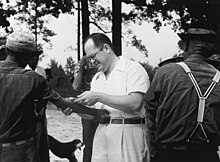Tuskegee Syphilis Study
The Tuskegee Syphilis Study was conducted in the Tuskegee , Alabama area from 1932 to 1972 by the United States Public Health Service (PHS), an agency of the United States Department of Health , under the direction of medical doctor John Charles Cutler . This study investigated the consequences of untreated syphilis infections, an often chronic sexually transmitted disease , in humans. 399 African-American sharecroppers - a type of land tenant - infected with syphilis were examined as part of the study. Another 200 people who were considered not to be infected with syphilis were included in the studies as a control group. Most of the test subjects were poor and could neither read nor write.
criticism
This study is known for its inhuman conduct: its purpose was to observe the natural course of syphilis disease. The study was not stopped when effective syphilis drugs became available. The test participants did not have the opportunity to give informed consent . They were also not given a diagnosis of syphilis . They were told instead that they had "bad blood" (English. Bad blood ) and that they have a free treatment would get. They would also free trips to the clinic, a hot meal daily and death get 50 dollars for the funeral.
Epidemiologist Peter Buxtun, who worked at the PHS, happened to find out about the study in autumn 1965 . Buxtun tried to get his authority to suspend the experiment, but, as in 1966, was unable to achieve anything with the US epidemic protection agency . Everywhere he was assured that the project would continue until the death of the last patient. Three years later he was told by the epidemic protection authorities that there were no moral concerns. Thereupon he inaugurated the journalist Jean Heller in 1972, who drew attention to the study with a report on July 25, 1972 in the Washington Evening Star . At the time, 74 of the people who participated in the start of the study were still alive. Having come under public pressure, the PHS called a committee of inquiry, which decided to terminate the study after three months. The lawyer Fred Gray , who had already represented Martin Luther King in court, finally obtained compensation of nine million US dollars in court for the survivors of the trial.
In another study, Cutler in Guatemala from 1946 to 1948 prisoners, soldiers and were mentally disabled persons suffering infected with syphilis. It should be examined whether penicillin can cure syphilis. In 2010, the US government apologized for these attempts.
literature
- Thomas G. Benedek: The "Tuskegee study" of syphilis. Analysis of moral versus methodological aspect. In: Journal of Chronical Diseases. Volume 31, 1978, pp. 35-50.
- FWO Kampmeier: Final Report on the "Tuskegee Syphilis Study". In: Southern Medical Journal. Volume 67, 1974, pp. 1349-1353.
Individual evidence
- ↑ Donald H. Rockwell, Ann R. Yobs, M. Brittain Moore: The Study of Untreated Syphilis by Tuskegee - After 30 Years of Observation. In: Nicolas Perthes et al. (Ed.): Human experiments. An anthology 1750-2000. Suhrkamp, Frankfurt am Main 2008.
- ↑ Racism - Bad Blood , report on the Tuskegee experiment in Der Spiegel , issue 40/1981
- ^ Christine Knust: Medical scandal: Deadly lie. In: Tagesspiegel of July 22, 2007
- ↑ Johanna Lutteroth: Medical scandal - Tuskegee death study. In: one day from June 7, 2012
- ↑ Obama apologizes for attempts at syphilis. Spiegel online , October 2, 2010
